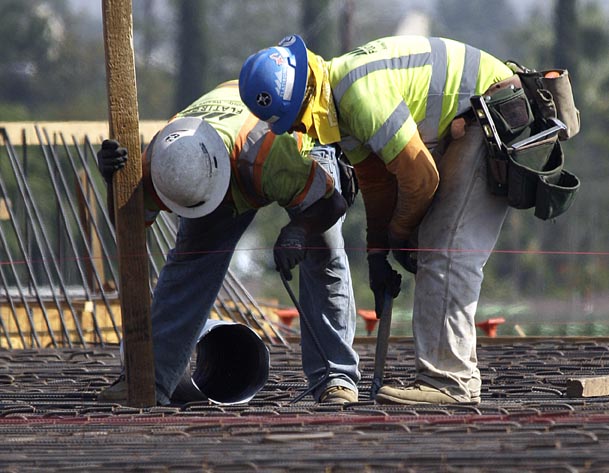WASHINGTON — The economy grew slightly faster in the spring than previously estimated but remained dangerously weak in the face of high unemployment and higher gas prices. Many economists foresee slightly better growth in the current July-September quarter.
The annual growth rate was 1.3 percent in the April-June quarter, up from an estimate of 1 percent made a month ago, the Commerce Department said today. The improvement reflected modestly more consumer spending and a bigger boost from trade.
Even with the upward revision, the economy grew at an annual rate of just 0.9 percent in the first six months of the year. That’s the weakest six-month performance since the recession ended more than two years ago.
Though most economists don’t expect another recession, they don’t see growth accelerating enough to lower the unemployment rate, which was 9.1 percent in August. Many predict a rebound to growth of between 2 percent and 2.5 percent in the current quarter.
However, that outlook would be better than the fears during the stock market turmoil in August that the economy could be in danger of slipping back into recession.
“The economy is not teetering on the edge of a cliff, getting ready to fall over into a recession,” said Christopher Rupkey, chief financial economist at Bank of Tokyo-Mitsubishi. “Growth looks on track for 2 percent in the third quarter and 3 percent in the fourth quarter.”
In a separate report, the government said the number of people seeking unemployment benefits fell sharply last week, an encouraging sign that layoffs are easing. The Labor Department said weekly applications dropped 37,000 to a seasonally adjusted 391,000.
That’s the lowest level since April 2. And it’s the first time that applications have fallen below 400,000 since Aug. 6.
A forecasting panel for the National Association for Business Economics predicts total growth for the year will be just 1.7 percent. In January, most economists had predicted 3 to 4 percent growth for the entire year. A Social Security tax cut gave Americans an extra $1,000 to $2,000 in after-tax income. That was expected to buoy consumer spending, which fuels 70 percent of growth.
But food and gas prices spiked, and those higher costs forced people to cut back on discretionary items, such as vacations, appliances and computers.
The 1.3 percent growth rate in the April-June period followed an even weaker 0.4 percent increase in the first three months of the year.
Economists expect consumer spending, which accounts for about 70 percent of economic activity, to strengthen slightly in the second half of this year. In part, that’s because the supply of sought-after car models will be available again as U.S. automakers resume more normal production.
Data in the current quarter has shown some improvement. But analysts warn that growth is still so weak that another recession remains a risk.
One of the big worries is that a default by heavily indebted Greece could trigger a financial crisis similar to the upheavals that occurred after the Lehman Brothers failure in 2008. Such a shock could be enough to push not only the United States but the global economy back into recession.
In the April-June quarter, consumer spending grew at an anemic 0.7 percent rate, though that was better than an estimate a month ago that spending had risen only 0.4 percent.
Trade added more to growth than estimated a month ago because exports grew at a faster pace and imports didn’t rise as rapidly. Exports add to U.S. growth, while imports subtract from it.
The NABE forecasting panel predicts overall growth of 2.1 percent in the July-September quarter and 2.3 percent in the October-December period. That pace is far below the levels needed to push the unemployment rate down significantly.
Facing decreased demand for their goods and services this year, businesses cut back on hiring. In August, the economy didn’t add any jobs — the weakest month for hiring in nearly a year.
Beth Ann Bovino, chief economist at Standard & Poor’s in New York, said the likely outlook is for the unemployment rate to remain around 9 percent through the rest of this year and the first part of 2012.
President Barack Obama has proposed a $447 billion job-creation package. He wants to cut Social Security taxes for workers, extend unemployment benefits, cut taxes for small businesses and spend more federal money to build roads, bridges and other public works projects.
But the president’s proposal faces opposition in Congress. Republicans object to his proposal to pay for the plan with higher taxes on wealthier households, hedge fund managers and oil companies.
Send questions/comments to the editors.



Success. Please wait for the page to reload. If the page does not reload within 5 seconds, please refresh the page.
Enter your email and password to access comments.
Hi, to comment on stories you must . This profile is in addition to your subscription and website login.
Already have a commenting profile? .
Invalid username/password.
Please check your email to confirm and complete your registration.
Only subscribers are eligible to post comments. Please subscribe or login first for digital access. Here’s why.
Use the form below to reset your password. When you've submitted your account email, we will send an email with a reset code.